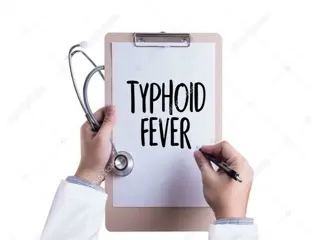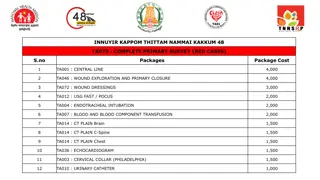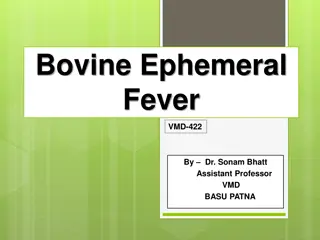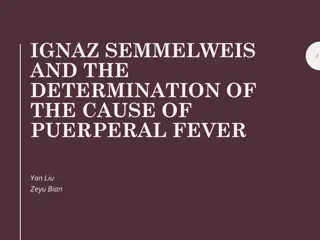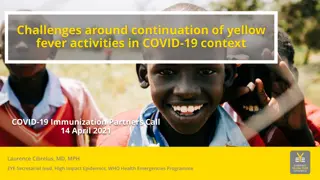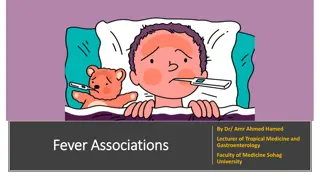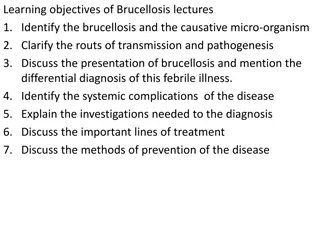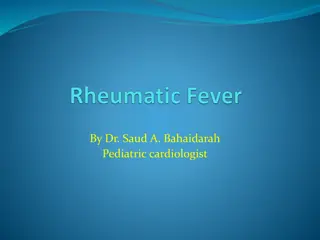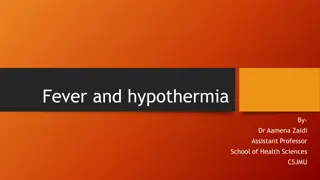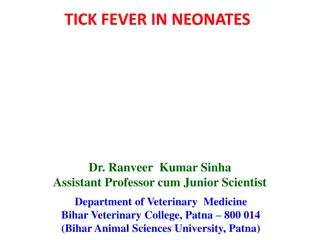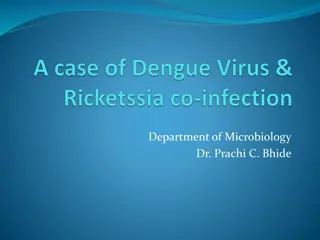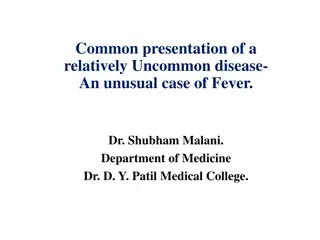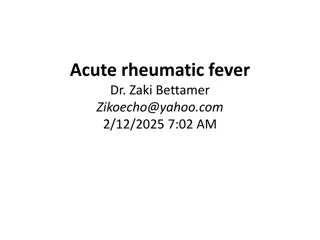
Understanding Yellow Fever Transmission and Epidemiology
Yellow fever, an acute viral infection transmitted by mosquitoes, is endemic in tropical regions of Africa and South America. The disease is underreported, with a significant number of cases and deaths each year. The life cycle of the mosquito vector plays a vital role in disease transmission. Learn about the risks, vectors, and prevention of yellow fever.
Download Presentation

Please find below an Image/Link to download the presentation.
The content on the website is provided AS IS for your information and personal use only. It may not be sold, licensed, or shared on other websites without obtaining consent from the author. If you encounter any issues during the download, it is possible that the publisher has removed the file from their server.
You are allowed to download the files provided on this website for personal or commercial use, subject to the condition that they are used lawfully. All files are the property of their respective owners.
The content on the website is provided AS IS for your information and personal use only. It may not be sold, licensed, or shared on other websites without obtaining consent from the author.
E N D
Presentation Transcript
YELLOW FEVER YELLOW FEVER
Introduction Introduction Yellow fever is an acute mosquito transmitted viral infection which is endemic and occasionally epidemic in many countries of tropical Africa and South America. It is also refered to as yellow Jack, black vomit, American plaque, and Asian fetish Main vectors are aedes and haemagogus mosquitoes.
Epidemiology Epidemiology Yellow fever is now found only in Sub saharan Africa, the amozonian region of South Africa and occasionally Trinidad. Africa accounts for around 90% of the cases. Yellow fever is grossly unreported due to unrecognised cases, unavailability of laboratory facilities to make the diagnosis, and poor surveillance. The WHO estimates that there are 200,000 cases a year with 30,000 deaths. Yellow fever appears to be on the rise due to deforestation, urbanisation and the increase of global travel.
Continue . Continue . Yellow fever belt in Africa lies between latitude 15-10 degree south of the equator Nigeria 1987 10.000 cases with about 5,000 deaths were reported. In Ghana in 1996 a total of 27 cases of yellow fever with 5deaths has been reported over a period of few weeks in the upper East Region of the County.
Life cycle Of vector Life cycle Of vector The female aedes Masquito lays eggs above water as compared to other Masquitos Eggs are laid singaly or in a group. These eggs have the ability to survive in dry conditions hence increasing the spread of the disease. Eggs hatch into larvae which extend in to water and have short shiphons and may dive to bottom if disturbed. After 4molts the larvae develop to become pupae which have 2 trumpets and after 4 days they become the adult mosquito which flies to find a mate.
Yellow fever virus Yellow fever virus It is a flavivirus 45-60nm An RNA envoloped virus Also classified ecologically as an arbovirus as its cycle involve the arthropods as vector and it has been observed that viral infection does not harming the vector
Transmission Transmission The vector is the Ad s aegypti or haemogogus mosquito there are two modes of transmission of the virus vertical and horizontal Vertical transmission occurs when the virus is passed on to the mosquito ovum This is advantageous for continuation of the life cycle during the dry season when the eggs may lay dormant When the rainy season returns, the egg hatch, allowing the virus to carry on. Horizontal transmission occurs when either an animal (typically monkeys ) are infected by the mosquito.
Continue . Continue . There are several different transmissions cycles I. Yellow fever sylvatic, intermediate, and urban. All three occurs in Africa, but only sylvatic and urban occur in South Africa. Sylvatic or jungle yellow fever occurs in tropical rainforests where monkeys are infected. Here humans are infected as a result of entering the forest. Risk groups include hunters farmers, chain saw operators construction workers.
Continue Continue Intermediate yellow fever occurs in the humid or semi humid savanhas of Africa where small epidemics occur in villages. Here mosquitoes infect both monkeys and humans at the same his zone of emergency. Urban yellow fever can occur in large epidemics where the virus is passed from human to human via domestic aedes mosquitoes.
Sylvatic or jungle yellow fever Sylvatic or jungle yellow fever Sylvatic yellow fever is spread to humans by the bites of haemogogus and aedes Africanus. These mosquitoes are infected when they feed on viraemic monkeys or becouse they inherited the infection by transovarial transmission from their mother. Urban yellow fever Urban yellow fever occurs in more populated areas and is usually transmitted by aedes aegypti Masquito which deposit their eggs in any container which can hold water, in or around houses perpetuating a Masquito to human to Masquito transmission cycle.
Pathophysiology Pathophysiology infected mosquito leads to viral spread to lymph nodes where they multiply and from there enter the circulation. Localises in the liver, spleen, bone marrow and lymph glands persisting for days in These areas. Localisation and propagation of the virus in a particular organ constitutes the lesions of yellow fever. Hemorrhage in the mucus after pylorus of the stomach kidney and liver necrosis (mid zonal with Councilman bodies) pervascular infiltration of the brain with mono nuclear cells. Degenerative changes in heart plane lymph nodes also occur bleeding is the result of a hemorrhagic diathesis.
Incubation period Incubation period Extrinsic incubation period 12-14 days period when an infected vector is not infectious Incubation period 3-6days period when an infected individual is asymptomatic.
Clinical manifestation Clinical manifestation Fever chills headache and backache followed by nausea and vomiting conjunctivitis retrobulvbar pain. On about the fourth day the period of intoxication starts with a slow pulse relative to high fever and moderate jaundice. In severe cases marked proteinuria and hemorrhagic manifestations block vomits epigastric pain. The degree of Jaundice and black vomit correlated with severity of disease and fatality. After 3to5 days of the disease either the patient recover or goes on to the next stage of Fulminant disease.
Continue .. Continue .. In Fulminant disease there is a significant hepatic injury with Jaundice upcoming hence the name yellow fever. Renal failure is not uncommon. A hemorrhagic diathesis may occur causing of epistaxis causing of epistaxis oozing at the gums ecchymosis hematemesis Malena haematuria thrombocytopenia and disseminated intravascular coagulation. Myocarditis Encephalopathy and shock may also occur
Diagnosis Diagnosis Clinical Serology Culture Biopsy Differential diagnosis Malaria Typhiod Viral hepatitis
Treatment Treatment Treatment for yellow fever is supportive in nature Bedrest under insecticides treated nets Analgesics Fluid and electrolytes balance Control Vaccination Vector control Surveillence
Control Control The 17D yellow fever vaccination is the only strain available It is alive, attenuated vaccine and has several contraindications including Children under 9 months of age Pregnancy Immunosuppression International regulations require a booster every 10 years to enter or depart from endemic yellow fever regions.
Continue Continue Vector control Elimination of breeding sites Insectisides Repelent creams Surveillance Prompt detection and management of cases.


